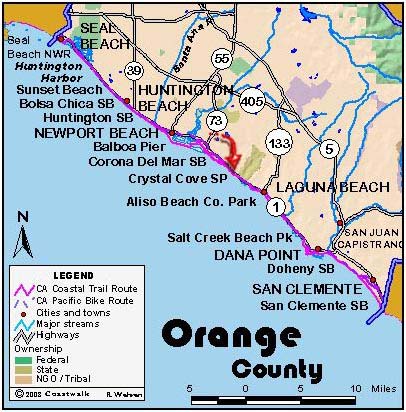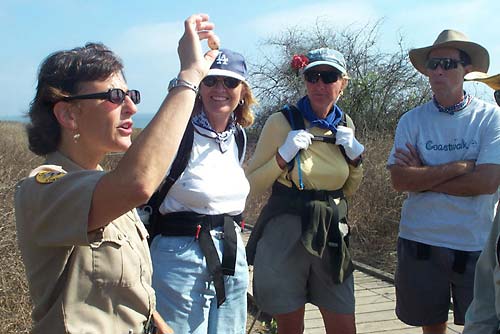


September 11: Orange County Intersection of Magnolia and PCH to Crystal Cove Park Historical District. 13.5 miles
Postscript to September 10: The CTE 03 hikers thank the anonymous couple in the “woodie” that came in the evening bringing pies and cookies.
Today we kept the Paces as leaders and gained two day-hikers and two section-hikers. Day hikers were Carol and Sonia Gregurek and the section hikers are Mary Andrusky and Laila Barr (who came from Seattle to walk with Mary). The day began with a remembrance of 9/11. For Northern Californians who do not venture much to the south, a description of a “typical” beach might be in order. Facing south, on your left is the Pacific Coast Highway or as we call it, Highway One. Flanking it and still on your left is a parking lot running as far as you can see, broken only by entrance kiosks and driveways. Occasionally, perhaps every half mile, will be a bathroom facility, often accompanied by a larger building which is leased to a concessionaire: food can be bought here as well as beach-stuff rented. Your hypothetical viewpoint is from the multi-use path, so before you a 10 foot wide ribbon of concrete stretches away into the distance. We now get to your right-hand side. There is at least ¼ mile (or so it seems) of flat sand between you and the Pacific. In some places, cement-campfire receptacles have been placed every 100 feet or so, each with an accompanying trashcan. Every 300 yards a life- guard station stands poised above the sand. I suppose that in season the sand is absolutely covered with people; today it is empty as we began our walk, but the multi-use ribbon is being used by bicyclists, joggers, rollerbladers and occasionally other walkers.
Our walk south along Huntington State Beach was stopped by the Santa Ana River where hikers must come inland to the PCH and cross on a bridge. On the southerly side of the river, the same sand is called the Santa Ana River County Beach. We encountered this beach at about 70th Street in Newport Beach, and at 36th were able to walk either on the sand or on the boardwalk which began there. Both routes led to the Newport Beach Pier and a short rest on the grass near the headquarters of the Dory Fishing Fleet. Here are stored dories from which fish are caught and then sold to passersby. It is an attempt to keep alive an old way of life that provided both fresh fish and a tourist magnet.
Another beach walk of two or so miles took us to the Balboa Pier and our lunch break. Along the way we detoured ½ block to Sonia’s home and a snack of cold sliced oranges. From the pier, we headed inland to Newport Bay and a 60-cent ferry ride to Balboa Island. We left the island via a bridge on Marine Avenue and made a right turn on Bayside Drive, which took us down via Fern Avenue to Ocean Boulevard at the top of the bluff. Here we could look back over most of our day’s hike to the Newport Pier.
Now we have entered southern Orange County and a landscape with a vertical component to it. We walked along roadways and the exclusive Corona del Mar section of stately homes to the northerly end of Crystal Cove State Park, where we met Ranger Winter Brown. Winter had a most unusual daypack. During the course of her talks with us, it yielded two hummingbirds, a grey whale, enough bird eggs for a really good omelet and two jars, one with whale barnacles in it and the other whale lice. She led us down to the shore, where we found some very active tide pools. Hermit crabs were walking about, and in one pool there were two sea hares, creatures that essentially are (or at least look like) foot-long slugs.
Winter led us to our camp spot for the night at the Crystal Cove Park Historical District. Here were 12 acres of cottages, all done in “vernacular architecture”, which is a nice way to say that the architecture was home grown and just came about as the people living here built homes, each in its own style. At first the Irvine Company, owners of the land, just let these cottages be. Then its bean counters got nervous and forced the cottage builders to pay rent. Finally in 1979 all the park lands were sold to the state, and a process of eviction started which has only recently been completed. At the tail end of Governor Wilson’s tenure, a deal was struck to build a fancy (i.e., expensive) resort and convention center here. The public outcry stopped that idea and now the area is protected as an historical district. The little cottages will be fixed up but not changed in any way. Most will be rented out at more reasonable fees to vacationers, some will be made into hostels, and a few will house the Crystal Cove staff. (Jon Breyfogle; photos, Linda Hanes) Left: The last dory fishing fleet. Right: Crystal Cove Ranger Winter Brown, with Sandra Pace, Diana Savage and George Pace
